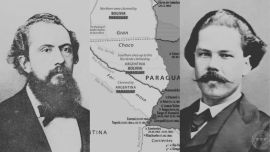An annual solar eclipse will create a rare "ring of fire" phenomenon visible in parts of South America on Wednesday.
A "ring of fire" occurs when the Moon lines up between the Sun and the Earth to create a solar eclipse but does not block out the Sun's light entirely, leaving a ring of light visible.
This year, the Moon will be further from the Earth than usual, so those in parts of Chile and Argentina will be able to witness "a kind of ring of light coming from the Suá," said Diego Hernandez, head of scientific dissemination at the Buenos Aires Planetarium.
A "crescent sun" will be visible before and after the ring, as the Moon passes in front of the Sun, he added.
The solar eclipse's path will begin in the North Pacific, pass over the Andes and Patagonia regions of Latin America, and finish in the Atlantic.
The eclipse will last more than three hours, from 17:00 to around 20:30 GMT, according to NASA.
But the "ring of fire" phenomenon is expected to last around six minutes, occurring around 1845 GMT, according to the IMCCE institute of France's Paris Observatory.
A partial eclipse will be visible from Bolivia, Peru, Paraguay, Uruguay, parts of Brazil, Mexico, New Zealand and several islands in the Pacific and Atlantic oceans, NASA said.
Freezing Santa Cruz Province the best spot
Although Argentina is in the path of this fantastic astronomical event, the "ring of fire" will be totally visible in a a strip of land that crosses the Province of Santa Cruz. The rest of the country will be able to see a partial eclipse.
Santa Cruz is one of the least densely populated in the country, with 1.5 inhabitants per km², according to Argentina's Defence Ministry.
Known for its desert environment, lined with dinosaur fossils that populate Argentine museums, and also for the fossil fuels that fill the gasoline dispensers in large cities, experts say Santa Cruz will be one of the best spots to view the "ring of fire."
However, the province also offers a challenging scenario for those awaiting the phenomenon – Argentina's meteorological services predicts a freezing temperature ranging between 1 and 11 ºC, and wind gusts that could reach 60 kilometres/hour.
Space agencies and institutes have warned against observing an eclipse with the naked eye, saying it can cause irreversible damage to the retina. Ordinary sunglasses offer insufficient protection.
The only safe methods, according to NASA and the IMCEE, are using certified special eclipse glasses, or watching indirectly through a pinhole in a cardboard sheet projecting the image of the eclipsed Sun onto a second cardboard sheet.
The next partial solar eclipse will take place on March 29, 2025, visible mainly from western North America, Europe and northwest Africa.
– TIMES/AFP


















Comments